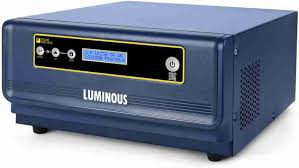There are different types of inverters based on their functionality, power output, and application. Here are the main types: 1. Based on Output Waveform a) Square Wave Inverter Cheapest and simplest type Not suitable for sensitive appliances (computers, TVs, etc.) Produces a lot of noise and is inefficient b) Modified Sine Wave Inverter More efficient than square wave inverters Suitable for basic home appliances (fans, lights, etc.) Slightly noisy and less efficient for sensitive electronics c) Pure Sine Wave Inverter (Best Option) Works with all types of appliances, including sensitive electronics Highly efficient and provides smooth power like the electricity grid Expensive but recommended for home and commercial use 2. Based on Power Source a) Standalone Inverter (Off-Grid Inverter) Works with a battery Ideal for homes or areas with frequent power cuts b) Grid-Tie Inverter (On-Grid Inverter) Directly connected to the electricity grid No need for batteries Used in solar systems to feed excess power back to the grid c) Hybrid Inverter Works both with and without the grid Can use solar panels, batteries, and grid power Best for solar-powered homes and businesses 3. Based on Application a) Solar Inverter Converts DC power from solar panels to AC Can be on-grid, off-grid, or hybrid b) Home Inverter Commonly used for household power backup Works with batteries to provide power during outages c) Commercial & Industrial Inverter High-capacity inverters for businesses, factories, and offices Can handle large power loads Which One Should You Choose? ✅ For home use with sensitive devices → Pure Sine Wave Inverter ✅ For basic power backup (fans, lights) → Modified Sine Wave Inverter ✅ For solar systems → Hybrid or Grid-Tie Inverter ✅ For large businesses → Industrial Inverter Let me know if you need recommendations! ⚡🔋
Chat with us on WhatsApp
×
This is your website preview.
Currently it only shows your basic business info. Start adding relevant business details such as description, images and products or services to gain your customers attention by using Boost 360 android app / iOS App / web portal.
https://www.tanushripowersolutions.in/latest-update/there-are-different-types-of-inverters-based-on-th/145
There are different types of inverters based on th...

2025-03-04T04:42:06
There are different types of inverters based on their functionality, power output, and application. Here are the main types: 1. Based on Output Waveform a) Square Wave Inverter Cheapest and simplest type Not suitable for sensitive appliances (computers, TVs, etc.) Produces a lot of noise and is inefficient b) Modified Sine Wave Inverter More efficient than square wave inverters Suitable for basic home appliances (fans, lights, etc.) Slightly noisy and less efficient for sensitive electronics c) Pure Sine Wave Inverter (Best Option) Works with all types of appliances, including sensitive electronics Highly efficient and provides smooth power like the electricity grid Expensive but recommended for home and commercial use 2. Based on Power Source a) Standalone Inverter (Off-Grid Inverter) Works with a battery Ideal for homes or areas with frequent power cuts b) Grid-Tie Inverter (On-Grid Inverter) Directly connected to the electricity grid No need for batteries Used in solar systems to feed excess power back to the grid c) Hybrid Inverter Works both with and without the grid Can use solar panels, batteries, and grid power Best for solar-powered homes and businesses 3. Based on Application a) Solar Inverter Converts DC power from solar panels to AC Can be on-grid, off-grid, or hybrid b) Home Inverter Commonly used for household power backup Works with batteries to provide power during outages c) Commercial & Industrial Inverter High-capacity inverters for businesses, factories, and offices Can handle large power loads Which One Should You Choose? ✅ For home use with sensitive devices → Pure Sine Wave Inverter ✅ For basic power backup (fans, lights) → Modified Sine Wave Inverter ✅ For solar systems → Hybrid or Grid-Tie Inverter ✅ For large businesses → Industrial Inverter Let me know if you need recommendations! ⚡🔋
2025-03-04T04:42:06
Keywords
- 2 based
- solarpowered homes
- businesses 3 based
- inverters based
- businesses factories
- ongrid offgrid
- battery ideal
- sensitive electronics
- slightly noisy
- simplest type
- grid power
- electricity grid
- provide power
- power source
- smooth power
- option works
- output waveform
- gridtie inverter
- solar panels
- solar systems
- solar panels batteries
- electricity grid expensive
- home inverter commonly
- solar systems hybrid
- hybrid inverter works
- functionality power output
- frequent power cuts

Submit Your Enquiry